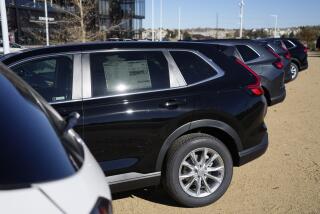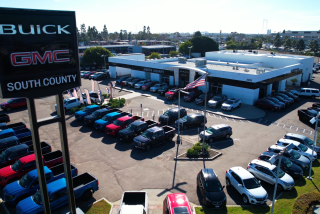Big Threeâs Auto Sales Surge 10.4% : Cars: Detroit continued to grab market share from the Japanese in 1993. Analysts see the trend lasting several years.
DETROIT â Chrysler Corp. picked an unusual venue for a dinner during the Detroit International Auto Show this week: a comedy club in the Motor Cityâs downtown theater district.
Chairman Robert Eaton delivered a serious but upbeat state-of-the-company speech Monday night--followed by a clever skit with the Second City comedy troupe that had his audience laughing out loud.
âThis is where people come to have fun,â Eaton said. âAnd we at Chrysler are having fun.â
The auto maker has some company in Detroit. The Big Three--all but given up for dead three years ago--reported Tuesday that their 1993 sales increased more than 10.4% over the previous year.
Overall, sales in America of both domestic and import vehicles climbed 8.5% to their highest level since 1990.
U.S. auto makers continued to grab market share from their Japanese competitors. Just as important, there is growing recognition that the quality of U.S. cars and the efficiency of U.S. factories are at world-class levels.
The expectations: Market trends will continue for several years, and auto sales should rise from 14 million last year to 15 million in 1994. Bullish industry officials expect sales of a record 17 million within a few years.
âThe next two years can be seen as the years of the American car industry,â said an admiring Helmut Panke, chairman and chief executive of BMWâs U.S. operations.
The recovery in Detroit has come with remarkable speed. Just two years ago--when Chrysler, Ford and General Motors together had operating losses of about $4 billion--the Big Three embarrassingly went hat in hand to Japan with President Bush asking for trade concessions.
Now it is the Japanese who have long faces at the auto shows--and the U.S. auto makers who are gloating.
The quick reversal of roles is as much a matter of circumstance and luck as it is the result of several years of gut-wrenching change and corporate soul-searching.
In part, the sales surge has been spurred by pent-up demand and aggressive marketing. The average car in use today is more than 8 years old. People simply need to replace aging vehicles.
Lower interest rates and mortgage refinancings have freed up cash, putting willing buyers in the showrooms. The companies are advertising âvalueâ prices, offering vehicles equipped with lots of options at lower costs.
And all this interest in buying cars came just as the Japanese were being hampered by adverse currency fluctuations and economic problems in Tokyo. The yen gained more than 15% in value against the dollar before weakening slightly toward yearâs end.
The yenâs rise forced up the price of Japanese cars, giving U.S. auto makers a price advantage of more than $2,000 on most competing models. Just last week, Toyota and Nissan raised prices again.
A severe recession in Japan has made matters worse. All the major Japanese auto makers saw income drop sharply last year. The problems at home were felt in U.S. subsidiaries, as management shake-ups and layoffs became commonplace.
The reverberations left their mark on the marketplace.
The Big Three now control 74% of the U.S. market, up from 72.4% at the end of 1992. The Japanese have a 23% share, down a point from the end of 1992 and down 3 points from year-end 1991.
Chrysler President Robert Lutz said Japanâs share of the U.S. auto market could decline another 4% to 5% over the next four to five years. But others are more cautious.
âThe Japanese are in a little bit of an uphill struggle, but I do not for one second undersell their ability to react,â said Richard Wagoner, chief financial officer of GM.
Indeed, Toyota, Nissan and Honda are fighting back by moving more production to the United States to counteract the yenâs strength. They are also luring customers with incentives and attractive financing programs.
âWe will take an aggressive position with short-term leasing,â said Richard Colliver, Hondaâs vice president of sales. Hondaâs sales were down 6.8% in 1993, apparently dropping the company to third place among importers, behind Toyota and a resurgent Nissan.
The Japanese are also being hurt because they sell few trucks--the hottest and most profitable segment of the U.S. vehicle market. That segment, which includes minivans, sport utility vehicles and pickups, is dominated by the Big Three. Detroitâs truck sales were up 16% last year; car sales were up only 6%.
Fordâs truck sales shot up 19% in 1993, accounting for 48% of its total 3.6 million in U.S. sales. Chrysler reported an 18% increase in truck sales, selling more than 500,000 minivans. GMâs truck sales jumped 13%.
Ford again counted the best-selling truck and car among its models: The F-Series pickup edged out Chevroletâs C/K pickup, and the Taurus sedan easily beat the Honda Accord for the second year in a row.
Such news is apparent in Cobo Center, site of the Detroit Auto Show. The Big Three have held elaborate news conferences, highlighted by the latest video technology and gimmickry. The Japanese firmsâ announcements have been terse, somber affairs.
Even GM executives appeared optimistic. The company has lost nearly $18 billion in North America since 1990. While it will report a loss in North America for 1993, the red ink has been sharply reduced, and GM promises a profit on the continent this year.
John F. Smith, GMâs chief executive and president, said sales and profit should improve in 1994 as the company continues to cut costs and introduces new products, including a redesigned Chevrolet Cavalier and new GMC Jimmy sport utility vehicle.
Probably no company is more upbeat than Chrysler.
On Monday, the auto maker announced that it will sell its subcompact Neon for a base price of $8,975. On Tuesday, Chrysler used a secret-agent spoof to unveil its new Dodge Stratus and Chrysler Cirrus, which will go on sale in the fall.
An American Success Story
Detroit auto makers recaptured a chunk of the domestic market from their Japanese competitors in 1993, driving total U.S. car and truck sales up for the year.
In thousands of vehicles
Import: 2,200 Domestic: 11,800
Source: Auto companies, American Automobile Manufacturers Assn.
Auto Market Share
General Motors, the worldâs biggest car maker, continued to lose market share last year. Ford and Chrysler posted significant gains, but every Japanese maker except Nissan lost ground.
1993 Market Share 1992 Market Share General Motors 33.6% 34.2% Ford 25.6 24.7 Chrysler 14.8 13.3 Toyota 7.4 8.0 Honda 5.2 6.0 Nissan 4.9 4.6 Mazda 2.5 2.6 Mitsubishi 1.3 1.4 Other 4.7 4.7
Sources: Auto companies, Wardâs Automotive Reports






